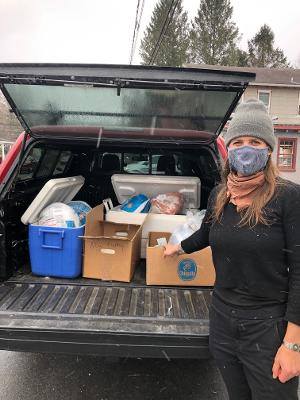Hudson Valley 360: Network feeds hungry and prevents waste
- hvadcuser
- Feb 10, 2021
- 4 min read
Updated: Mar 2, 2021
February 5, 2021 - Columbia Greene Media
By Aliya Schneider
HUDSON — The Feed HV Community Food Network team is on a mission to make sure no food goes to waste with a network of volunteers that spans the Hudson Valley.
The program transports leftover food to those who need it by connecting volunteers with donors and receiving agencies.
Feed HV Community Food Network was founded in late 2017 by the Community Foundations of the Hudson Valley. It was taken over by the Hudson Valley AgriBusiness Development Corporation, 507 Warren St., said Mary Ann Johnson, the corporation’s deputy director.
The network incorporates receiving agencies, emergency feeding programs, volunteers and donors such as farms, restaurants, schools and institutions, Johnson said. The app ChowMatch pairs volunteers with donors and recipients. Volunteers can sign up to deliver donated food to a nearby agency that supplies it to people in need.
The program covers counties in the Hudson Valley, including Columbia and Greene.
Donors in both counties have included Gracie’s Luncheonette in Leeds, Field Goods in Athens, and Thyme & Co. and Hudson Valley Fisheries in Hudson, FeedHV Program Coordinator Brianna Merrill said. Recipients include Long Table Harvest in Germantown, Catholic Charities of Columbia and Greene Counties in Catskill, Hudson Youth Department, Prabhuji Mission in Round Top, High Hill Food Pantry in Athens, Coxsackie Area Food Pantry and Catskill Community Center. The Columbia County Recovery Kitchen joined the network Monday.
“Feed HV has been strengthening relationships with local organizations like Community Action of Greene County, but are in need of donors and volunteers in the area,” Merrill said.
According to the 2019 Poverty Report issued by the New York State Community Action Association, 12.4% of the population of Greene County, 11.4% of Columbia County and 19.2% of Hudson live in poverty, compared to 15.1% of people statewide. According to 2018 U.S. Census data, 11% of Columbia County households and 8% of Greene households receive SNAP benefits, the federal Supplemental Nutrition Assistance Program that provides food assistance to eligible low-income individuals and families.
The food network had an influx of donations for the first couple of weeks of the COVID-19 shutdown in the spring, Johnson said. For example, the IBM corporate cafeteria was no longer operating and had a lot of leftover food. On the receiving end, agencies saw a large increase in food needs over the following months, with anywhere from 40% to 60% increases in recipients, Johnson said.
“The network of people doing this work really came together early on to make sure they could try to help as many people as they could and help the agencies that were serving much larger numbers,” she said.
Many of the volunteers are older adults and didn’t feel comfortable doing food runs during the pandemic, but local partners came together to get the food delivered, Johnson said.
“We filled food runs with staff,” Johnson said. “We tried to not let any food go to waste. It was volunteers, it was staff, it was family of staff, whatever we could do to make it work,” she said. “And then, of course, we also reached out to our partners in our region.”
The program has seen a recent increase of fresh produce donated by farms, she said.
Many farms pivoted to retail sales during the pandemic and have done pretty well, Johnson said. Mid-scale farms that typically sell wholesale to restaurants lost sales opportunities and have had extra food to donate.
Food donations have decreased since the early days of the pandemic, but as colleges open for spring semester, the program expects donations to pick back up, Johnson said.
“We’re not at the levels we were, but we’re hopeful we can continue to do what we do,” she said.
Feed HV received a $2,500 grant from the Cabot Creamery Cooperative sponsored by CoBank, a national cooperative bank serving the rural United States. The program won the award because of tracked volunteer hours.
Program leaders didn’t know the hours were being tracked for the grant, so the award came as a surprise, Johnson said. The volunteer who signed up for the program has remained anonymous.
The Hudson Valley AgriBusiness Development Corporation, which oversees Feed HV, was formed to support business and economic needs of farms and local food businesses, Johnson said. The corporation’s association with farms, restaurants and markets connected well with Feed HV’s mission.
“It became apparent that Feed HV could feed a niche that these bigger gleaning organizations were struggling a bit with,” Johnson said.
For example, some smaller organizations could have a couple of boxes of tomatoes to donate, which is insufficient for a gleaning vehicle but ideal for a volunteer who can put the boxes in the back of a car and drive to an emergency feeding program.
“Our relationship with farms and restaurants made it sort of a natural fit,” she said of the corporation taking over the food network. “ ... Farmers, they don’t want to see food go to waste. That’s not what they do. That’s not what they want to do. So it worked out really well and we could fill that need and help make those connections.” The Community Foundations of the Hudson Valley and other foundations including the NoVo Foundation, Local Economies Project, Ascienzio Family Foundation, Mother Cabrini Health Foundation, Ralph E. Ogden Foundation, Louis Greenspan Charitable Trust, The Thompson Family Foundation, as well as the Bruderhof Family and anonymous donors fund the food network, according to the program’s website. Funding goes toward staff, marketing, software enhancement and other operational costs, Johnson said.
“As well as the software works, people still need that human touch,” Johnson said. “If they’re having a problem, sometimes you go on a food run and the food isn’t there that you’re expecting. Things happen so you have to be able to call somebody.”
A radio campaign in the fall resulted in new volunteers and donors, so the program will likely use the Cabot grant funds for more marketing, Johnson said.
“We’re always looking for volunteers and we’re always looking for donors,” she said. “And so I would encourage people, if they’re so inclined, to please reach out to us and we will do our best to match them up and make it work.”
Food runs typically take about two hours, Johnson said. Volunteers can choose how many runs they do. Typically the opportunities to sign up are weekly, but it depends on the season.
To participate as a donor or receiving agency, visit FeedHV.org.














Comments